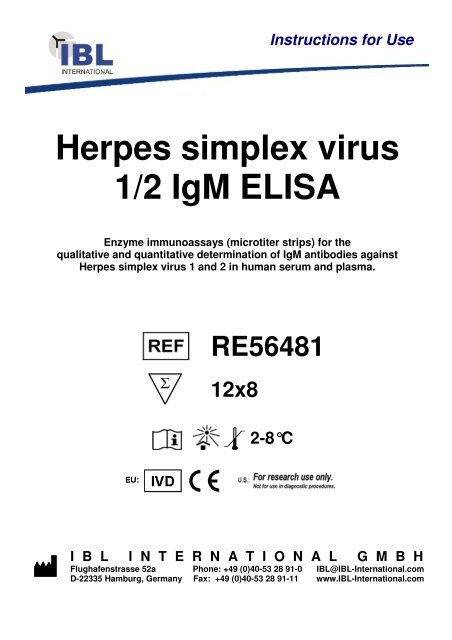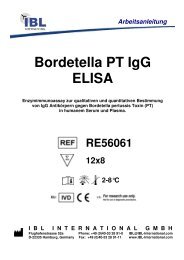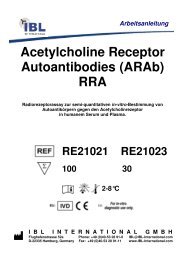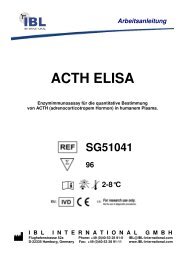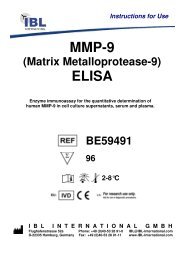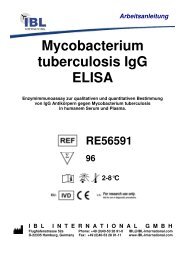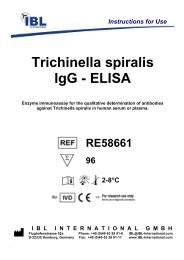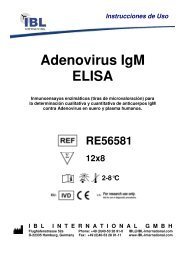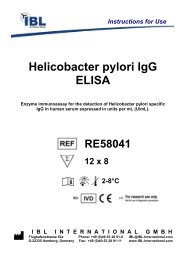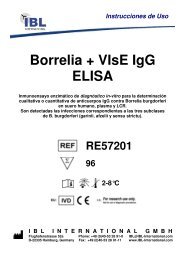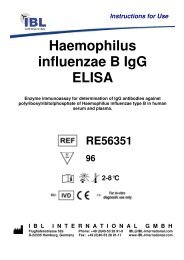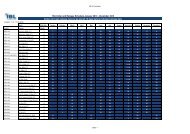Herpes simplex virus 1/2 IgM ELISA - IBL international
Herpes simplex virus 1/2 IgM ELISA - IBL international
Herpes simplex virus 1/2 IgM ELISA - IBL international
You also want an ePaper? Increase the reach of your titles
YUMPU automatically turns print PDFs into web optimized ePapers that Google loves.
Instructions for Use<br />
<strong>Herpes</strong> <strong>simplex</strong> <strong>virus</strong><br />
1/2 <strong>IgM</strong> <strong>ELISA</strong><br />
Enzyme immunoassays (microtiter strips) for the<br />
qualitative and quantitative determination of <strong>IgM</strong> antibodies against<br />
<strong>Herpes</strong> <strong>simplex</strong> <strong>virus</strong> 1 and 2 in human serum and plasma.<br />
RE56481<br />
12x8<br />
2-8°C<br />
I B L I N T E R N A T I O N A L G M B H<br />
Flughafenstrasse 52a Phone: +49 (0)40-53 28 91-0 <strong>IBL</strong>@<strong>IBL</strong>-International.com<br />
D-22335 Hamburg, Germany Fax: +49 (0)40-53 28 91-11 www.<strong>IBL</strong>-International.com
<strong>Herpes</strong> <strong>simplex</strong> <strong>virus</strong> 1/2 <strong>IgM</strong> <strong>ELISA</strong> (RE56481)<br />
ENGLISH<br />
1. INTENDED USE<br />
Enzyme immunoassays (microtiter strips) for the qualitative and quantitative determination of <strong>IgM</strong> antibodies<br />
against <strong>Herpes</strong> <strong>simplex</strong> <strong>virus</strong> 1 and 2 in human serum and plasma.<br />
2. SUMMARY AND EXPLANATION<br />
The <strong>Herpes</strong> <strong>simplex</strong> <strong>virus</strong>es type 1 and 2 are ubiquitous pathogens of humans that usually cause either<br />
asymptomatic infection or mild skin and mucosal diseases. HSV 1 causes 85 % and HSV 2 15 % of oral<br />
primary infections. HSV 1 causes different clinical symptoms in about 10 % of the primary infections like<br />
gingivostomatitis, keratitis, conjunctivitis, vesicular eruptions of the skin, encephalitis, eczema and some<br />
letal infections of newborns. Persons at an increased risk for serious or prolonged HSV infections are those<br />
with eczema, severe burns or a defect in their cell-mediated immunity.<br />
HSV 2 may cause other symptoms like the <strong>Herpes</strong> genitalis syndrome occurring principally in adults. The<br />
preceding primary infection will be transmitted via sexual contact. HSV 2 is a <strong>virus</strong> suspected to induce<br />
cervix carcinoma in women. In some cases a HSV 2 caused meningitis occurs that is much milder than a<br />
HSV 1 caused encephalitis. The most severe complication of genital HSV infection is the neonatal disease.<br />
Diagnosis of the primary infection by HSV 1 / HSV 2 can be confirmed by a significant rise of the IgG titer<br />
within 6 to 10 days. A finished infection can be monitored with the IgG <strong>ELISA</strong>. In case of a suspicion of HSV<br />
encephalopathy it is recommended to perform a parallel determination of both HSV-specific antibodies (IgG<br />
and <strong>IgM</strong>) in serum and liquor.<br />
3. TEST PRINCIPLE<br />
Solid phase enzyme-linked immunosorbent assay (<strong>ELISA</strong>) based on the sandwich principle. The wells are<br />
coated with antigen. Specific antibodies of the sample binding to the antigen coated wells are detected by a<br />
secondary enzyme conjugated antibody (E-Ab) specific for human <strong>IgM</strong>. After the substrate reaction the<br />
intensity of the color developed is proportional to the amount of <strong>IgM</strong>-specific antibodies detected. Results of<br />
samples can be determined directly using the standard curve.<br />
4. WARNINGS AND PRECAUTIONS<br />
1. For in-vitro diagnostic use only. For professional use only.<br />
2. Before starting the assay, read the instructions completely and carefully. Use the valid version of the<br />
package insert provided with the kit. Be sure that everything is understood.<br />
3. In case of severe damage of the kit package please contact <strong>IBL</strong> or your supplier in written form, latest<br />
one week after receiving the kit. Do not use damaged components in test runs, but keep safe for<br />
complaint related issues.<br />
4. Obey lot number and expiry date. Do not mix reagents of different lots. Do not use expired reagents.<br />
5. Follow good laboratory practice and safety guidelines. Wear lab coats, disposable latex gloves and<br />
protective glasses where necessary.<br />
6. Reagents of this kit containing hazardous material may cause eye and skin irritations. See MATERIALS<br />
SUPPLIED and labels for details. Material Safety Data Sheets for this product are available on the <strong>IBL</strong>-<br />
Homepage or upon request directly from <strong>IBL</strong>.<br />
7. Chemicals and prepared or used reagents have to be treated as hazardous waste according to national<br />
biohazard and safety guidelines or regulations.<br />
8. Avoid contact with Stop solution. It may cause skin irritations and burns.<br />
9. Some reagents contain sodium azide (NaN 3 ) as preservatives. In case of contact with eyes or skin, flush<br />
immediately with water. NaN 3 may react with lead and copper plumbing to form explosive metal azides.<br />
When disposing reagents, flush with a large volume of water to avoid azide build-up.<br />
10. All reagents of this kit containing human serum or plasma have been tested and were found negative for<br />
anti-HIV I/II, HBsAg and anti-HCV. However, a presence of these or other infectious agents cannot be<br />
excluded absolutely and therefore reagents should be treated as potential biohazards in use and for<br />
disposal.<br />
V2012_08 1 / 6
<strong>Herpes</strong> <strong>simplex</strong> <strong>virus</strong> 1/2 <strong>IgM</strong> <strong>ELISA</strong> (RE56481)<br />
ENGLISH<br />
5. STORAGE AND STABILITY<br />
The kit is shipped at ambient temperature and should be stored at 2-8 °C. Keep away from heat or direct<br />
sun light. The storage and stability of specimen and prepared reagents is stated in the corresponding<br />
chapters.<br />
The microtiter strips are stable up to the expiry date of the kit in the broken, but tightly closed bag when<br />
stored at 2–8 °C.<br />
6. SPECIMEN COLLECTION AND STORAGE<br />
Serum, Plasma (EDTA, Heparin)<br />
The usual precautions for venipuncture should be observed. It is important to preserve the chemical<br />
integrity of a blood specimen from the moment it is collected until it is assayed. Do not use grossly<br />
hemolytic, icteric or grossly lipemic specimens. Samples appearing turbid should be centrifuged before<br />
testing to remove any particulate material.<br />
Storage: 2-8 °C -20 °C<br />
Stability: 2 days > 2 days<br />
7. MATERIALS SUPPLIED<br />
Quantity Symbol Component<br />
1 x 12 x 8 MTP<br />
1 x 15 mL ENZCONJ <strong>IgM</strong><br />
1 x 4 x 2 mL CAL A-D<br />
1 x 60 mL DILBUF<br />
Microtiter Plate<br />
Break apart strips. Coated with specific antigen.<br />
Keep away from heat or direct sun light.<br />
Avoid repeated freeze-thaw cycles.<br />
Enzyme Conjugate <strong>IgM</strong><br />
Red colored. Ready to use. Contains: anti-human <strong>IgM</strong>, conjugated to peroxidase,<br />
protein-containing buffer, stabilizers.<br />
Standard A-D<br />
1; 10; 50; 100 U/mL. Ready to use.<br />
Standard A = Negative Control<br />
Standard B = Cut-Off Control<br />
Standard C = Weakly Positive Control Standard D = Positive Control<br />
Contains: <strong>IgM</strong> antibodies against HSV 1/2, PBS, stabilizers.<br />
Diluent Buffer<br />
Ready to use. Contains: PBS Buffer, BSA, < 0.1 % NaN 3.<br />
1 x 60 mL WASHBUF CONC Wash Buffer, Concentrate (10x)<br />
Contains: PBS Buffer, Tween 20.<br />
1 x 15 mL TMB SUBS<br />
1 x 15 mL TMB STOP<br />
2 x FOIL<br />
1 x BAG<br />
TMB Substrate Solution<br />
Ready to use. Contains: TMB.<br />
TMB Stop Solution<br />
Ready to use. 0.5 M H 2SO 4.<br />
Adhesive Foil<br />
For covering of Microtiter Plate during incubation.<br />
Plastic Bag<br />
Resealable. For dry storage of non-used strips.<br />
8. MATERIALS REQUIRED BUT NOT SUPPLIED<br />
1. RF Absorbent (can be ordered separately from <strong>IBL</strong> under REF KIRF561)<br />
2. Micropipettes (Multipette Eppendorf or similar devices, < 3 % CV). Volumes: 5; 100; 500 µL<br />
3. Calibrated measures<br />
4. Tubes (1 mL) for sample dilution<br />
5. 8-Channel Micropipettor with reagent reservoirs<br />
6. Wash bottle, automated or semi-automated microtiter plate washing system<br />
7. Microtiter plate reader capable of reading absorbance at 450 nm (reference wavelength 600-650 nm)<br />
8. Bidistilled or deionised water<br />
9. Paper towels, pipette tips and timer<br />
V2012_08 2 / 6
<strong>Herpes</strong> <strong>simplex</strong> <strong>virus</strong> 1/2 <strong>IgM</strong> <strong>ELISA</strong> (RE56481)<br />
ENGLISH<br />
9. PROCEDURE NOTES<br />
1. Any improper handling of samples or modification of the test procedure may influence the results. The<br />
indicated pipetting volumes, incubation times, temperatures and pretreatment steps have to be<br />
performed strictly according to the instructions. Use calibrated pipettes and devices only.<br />
2. Once the test has been started, all steps should be completed without interruption. Make sure that<br />
required reagents, materials and devices are prepared ready at the appropriate time. Allow all reagents<br />
and specimens to reach room temperature (18-25 °C) and gently swirl each vial of liquid reagent and<br />
sample before use. Mix reagents without foaming.<br />
3. Avoid contamination of reagents, pipettes and wells/tubes. Use new disposable plastic pipette tips for<br />
each component and specimen. Do not interchange caps. Always cap not used vials. Do not reuse<br />
wells/tubes or reagents.<br />
4. It is advised to determine samples in duplicate to be able to identify potential pipetting errors.<br />
5. Use a pipetting scheme to verify an appropriate plate layout.<br />
6. Incubation time affects results. All wells should be handled in the same order and time sequences. It is<br />
recommended to use an 8-channel Micropipettor for pipetting of solutions in all wells.<br />
7. Microplate washing is important. Improperly washed wells will give erroneous results. It is recommended<br />
to use a multichannel pipette or an automatic microplate washing system. Do not allow the wells to dry<br />
between incubations. Do not scratch coated wells during rinsing and aspiration. Rinse and fill all<br />
reagents with care. While rinsing, check that all wells are filled precisely with Wash Buffer, and that there<br />
are no residues in the wells.<br />
8. Humidity affects the coated wells/tubes. Do not open the pouch until it reaches room temperature.<br />
Unused wells/tubes should be returned immediately to the resealed pouch including the desiccant.<br />
10. PRE-TEST SETUP INSTRUCTIONS<br />
In order to avoid interferences of specific IgG and rheumatoid factors, patient sera should be<br />
treated with RF absorbent (REF KIRF561).<br />
10.1. Preparation of Components<br />
The contents of the kit for 96 determinations can be divided into 3 separate runs.<br />
The volumes stated below are for one run with 4 strips (32 determinations).<br />
Dilute /<br />
dissolve<br />
20 mL<br />
Component Diluent Relation Remarks Storage Stability<br />
WASHBUF<br />
CONC<br />
200 mL<br />
bidist.<br />
water<br />
1:11<br />
Warm up at 37 °C to dissolve<br />
crystals, if necessary.<br />
Mix vigorously.<br />
2-8 °C 8 w<br />
1 mL RF-Absorbent 20 mL DILBUF 1:21 Incubate ≥ 1 min. 2-8 °C 8 w<br />
10.2. Dilution of Samples<br />
Sample to be diluted with Relation Remarks<br />
Serum / Plasma generally DILBUF (+ RF-Absorbent) 1:101 e.g. 5 µL + 500 µL DILBUF<br />
Samples containing concentrations higher than the highest standard have to be diluted further.<br />
Samples with RF-Absorbent: Do not incubate >20 min to avoid adsorption of specific antibodies.<br />
Pretreated samples may be turbid.<br />
V2012_08 3 / 6
<strong>Herpes</strong> <strong>simplex</strong> <strong>virus</strong> 1/2 <strong>IgM</strong> <strong>ELISA</strong> (RE56481)<br />
ENGLISH<br />
11. TEST PROCEDURE<br />
1. Pipette 100 µL of each Standard and diluted sample into the respective wells of the Microtiter<br />
Plate. In the qualitative test only Standard B is used.<br />
2. Cover plate with adhesive foil. Incubate 60 min at 18-25 °C.<br />
3. Remove adhesive foil. Discard incubation solution. Wash plate 3 x with 300 µL of diluted Wash<br />
Buffer. Remove excess solution by tapping the inverted plate on a paper towel.<br />
4. Pipette 100 µL of Enzyme Conjugate into each well.<br />
5. Cover plate with new adhesive foil. Incubate 30 min at 18-25 °C.<br />
6. Remove adhesive foil. Discard incubation solution. Wash plate 3 x with 300 µL of diluted Wash<br />
Buffer. Remove excess solution by tapping the inverted plate on a paper towel.<br />
7. For adding of Substrate and Stop Solution use, if available, an 8-channel Micropipettor. Pipetting<br />
should be carried out in the same time intervals for Substrate and Stop Solution. Use positive<br />
displacement and avoid formation of air bubbles.<br />
8. Pipette 100 µL of TMB Substrate Solution into each well.<br />
9. Incubate 20 min at 18-25 °C in the dark (without adhesive foil).<br />
10. Stop the substrate reaction by adding 100 µL of TMB Stop Solution into each well. Briefly mix<br />
contents by gently shaking the plate. Color changes from blue to yellow.<br />
11. Measure optical density with a photometer at 450 nm (Reference-wavelength: 600-650 nm) within<br />
60 min after pipetting of the Stop Solution.<br />
12. QUALITY CONTROL<br />
The test results are only valid if the test has been performed following the instructions. Moreover the user<br />
must strictly adhere to the rules of GLP (Good Laboratory Practice) or other applicable standards/laws. All<br />
standards/controls must be found within the acceptable ranges as stated on the QC Certificate. If the criteria<br />
are not met, the run is not valid and should be repeated. Each laboratory should use known samples as<br />
further controls. It is recommended to participate at appropriate quality assessment trials.<br />
In case of any deviation the following technical issues should be proven: Expiration dates of (prepared)<br />
reagents, storage conditions, pipettes, devices, incubation conditions and washing methods.<br />
13. CALCULATION OF RESULTS<br />
The evaluation of the test can be performed either quantitatively or qualitatively.<br />
13.1. Qualitative Evaluation<br />
The Cut-off value is given by the optical density (OD) of the Standard B (Cut-off standard). The Cut-off index<br />
(COI) is calculated from the mean optical densities of the sample and Cut-off value. If the optical density of<br />
the sample is within a range of 20 % around the Cut-off value (grey zone), the sample has to be considered<br />
as borderline. Samples with higher ODs are positive, samples with lower ODs are negative.<br />
For a quantification, the Cut-off index (COI) of the samples can be<br />
formed as follows:<br />
COI =<br />
OD Sample<br />
OD Standard B<br />
13.2. Quantitative Evaluation<br />
The obtained OD of the standards (y-axis, linear) are plotted against their concentration (x-axis, logarithmic)<br />
either on semi-logarithmic graph paper or using an automated method. A good fit is provided with cubic<br />
spline or point-to-point curve, because these methods give the highest accuracy in the data calculation.<br />
For the calculation of the standard curve, apply each signal of the standards (one obvious outlier of<br />
duplicates might be omitted and the more plausible single value might be used).<br />
The concentration of the samples can be read directly from the standard curve.<br />
The initial dilution has been taken into consideration when reading the results from the graph. Results of<br />
samples of higher predilution have to be multiplied with the dilution factor.<br />
Samples showing concentrations above the highest standard have to be diluted as described in PRE-TEST<br />
SETUP INSTRUCTIONS and reassayed.<br />
V2012_08 4 / 6
<strong>Herpes</strong> <strong>simplex</strong> <strong>virus</strong> 1/2 <strong>IgM</strong> <strong>ELISA</strong> (RE56481)<br />
ENGLISH<br />
Typical Calibration Curve<br />
(Example. Do not use for calculation!)<br />
Standard U/mL OD Mean<br />
A 1 0.008<br />
B 10 0.398<br />
C 50 0.744<br />
D 100 1.727<br />
(OD)<br />
2.000<br />
1.500<br />
1.000<br />
0.500<br />
0.000<br />
<strong>Herpes</strong> <strong>simplex</strong> <strong>virus</strong> 1/2 <strong>IgM</strong> <strong>ELISA</strong><br />
1 10 100 1000<br />
(U/mL)<br />
14. INTERPRETATION OF RESULTS<br />
Method Range Interpretation<br />
< 8 U/mL negative<br />
8 – 12 U/mL equivocal<br />
> 12 U/mL positive<br />
< 0.8 negative<br />
0.8 – 1.2 equivocal<br />
Quantitative<br />
(Standard curve)<br />
Qualitative<br />
(Cut-off Index, COI)<br />
> 1.2 positive<br />
The results themselves should not<br />
be the only reason for any<br />
therapeutical consequences. They<br />
have to be correlated to other clinical<br />
observations and diagnostic tests.<br />
15. EXPECTED VALUES<br />
In an in-house study, apparently healthy subjects showed the following results:<br />
Interpretation<br />
Ig Isotype n<br />
positive equivocal negative<br />
<strong>IgM</strong> 56 0 % 0 % 100 %<br />
16. LIMITATIONS OF THE PROCEDURE<br />
Specimen collection has a significant effect on the test results. See SPECIMEN COLLECTION AND<br />
STORAGE for details.<br />
For cross-reactivities, see PERFORMANCE.<br />
Azide and thimerosal at concentrations > 0.1 % interfere in this assay and may lead to false results.<br />
The following blood components do not have a significant Hemoglobin<br />
8.0 mg/mL<br />
effect (+/- 20 % of expected) on the test results up to the Bilirubin<br />
0.3 mg/mL<br />
below stated concentrations: Triglyceride 5.0 mg/mL<br />
17. PERFORMANCE<br />
Analytical Specificity<br />
(Cross Reactivity)<br />
No cross-reactivities were found to:<br />
Measles, Mumps, VZV <strong>IgM</strong><br />
Precision Mean (U/mL) CV (%)<br />
Intra-Assay 51 4.2<br />
Inter-Assay 50 7.9<br />
Range (U/mL) Serial dilution up to Range (%)<br />
Linearity<br />
1.8 – 63 1/8 64 - 121<br />
Recovery 85 – 93 % % Recovery after spiking (n = 3)<br />
Method Comparison Rel. Sensitivity > 95 %<br />
versus <strong>ELISA</strong> Rel. Specificity > 95 %<br />
V2012_08 5 / 6
<strong>Herpes</strong> <strong>simplex</strong> <strong>virus</strong> 1/2 <strong>IgM</strong> <strong>ELISA</strong> (RE56481)<br />
ENGLISH<br />
18. PRODUCT LITERATURE REFERENCES<br />
1. Balows, Hauslin, Ohasi, Turono: In: "Laboratory Diagnosis of Infectious Diseases. Principles and<br />
Practice". Springer Verlag Berlin, Heidelberg, London, Paris, Tokyo: 212 (1988).<br />
2. Corey L, Spear PG. Infections with <strong>Herpes</strong> <strong>simplex</strong> <strong>virus</strong>es (1 + 2). N. Engl. J. Med., 314: 686 (1986).<br />
3. Johnston SL, Wellens K. Comparative evaluation of four commercially available monoclonal antibodies<br />
for culture confirmation of <strong>Herpes</strong> <strong>simplex</strong> infection. J. Clin. Microbiol., 30: 1874 (1992).<br />
4. Lafferty WE, Coombs RB, Beneditti J et al. Recurrences after oral and genital <strong>Herpes</strong> <strong>simplex</strong> <strong>virus</strong>.<br />
Influence of site of infection and viral type. N. Engl. J. Med., 316: 1444 (1987).<br />
5. Rabie-Finger I, Valentine-Thon E, Steinmann J, Nehrkorn A. Serological responses to <strong>Herpes</strong> <strong>simplex</strong><br />
<strong>virus</strong> type 1 (HSV-1) analysed with Enzyme-linked Immunosorbent Assay (<strong>ELISA</strong>) and Western Blot<br />
(WB). Acta virol., 35: 113 (1991).<br />
6. Rose RR, Friedmann H, Fahey JL. In: "Manual of Clinical Laboratory Immunology" (third edition);<br />
American Society for Microbiology, Washington, D.C.: 497 (1987).<br />
7. Sunstrum J. <strong>Herpes</strong> <strong>simplex</strong> infections: A review. J. Clin. Immunoass., 12: 175 (1989).<br />
8. Zheng ZM, Mayo DR, Hsiung GD. Comparison of biological, biochemical, immunological techniques for<br />
typing <strong>Herpes</strong> <strong>simplex</strong> <strong>virus</strong> isolates. J. Clin. Microbiol., 17: 396 (1983).<br />
9. Enders G. <strong>Herpes</strong> <strong>simplex</strong>. In: Infektionen und Impfungen in der Schwangerschaft, S. 54, Urban und<br />
Schwarzenberg, München (1990).<br />
10. Wutzler P in: T. Postmann Diagn. Bibliothek, Vol. 18 (1993), Blackwell Wissenschaftsverlag.<br />
11. Selb B. Medizinische Virusdiagnostik (1992), Umschlau Verlag, Frankfurt.<br />
12. Thomas L. Labor und Diagnostik, 4. Auflage (1992), Med. Verlagsgesellschaft, Marburg.<br />
V2012_08 6 / 6
Symbols / Symbole / Symbôles / Símbolos / Símbolos / Σύµβολα<br />
REF<br />
LOT<br />
Cat.-No.: / Kat.-Nr.: / No.- Cat.: / Cat.-No.: / N.º Cat.: / N.–Cat.: / Αριθµός-Κατ.:<br />
Lot-No.: / Chargen-Bez.: / No. Lot: / Lot-No.: / Lote N.º: / Lotto n.: / Αριθµός -Παραγωγή:<br />
Use by: / Verwendbar bis: / Utiliser à: / Usado por: / Usar até: / Da utilizzare entro: /<br />
Χρησιµοποιείται από:<br />
No. of Tests: / Kitgröße: / Nb. de Tests: / No. de Determ.: / N.º de Testes: / Quantità dei tests: /<br />
Αριθµός εξετάσεων:<br />
CONC Concentrate / Konzentrat / Concentré / Concentrar / Concentrado / Concentrato / Συµπύκνωµα<br />
LYO<br />
IVD<br />
Lyophilized / Lyophilisat / Lyophilisé / Liofilizado / Liofilizado / Liofilizzato / Λυοφιλιασµένο<br />
In Vitro Diagnostic Medical Device. / In-vitro-Diagnostikum. / Appareil Médical pour Diagnostics In<br />
Vitro. / Dispositivo Médico para Diagnóstico In Vitro. / Equipamento Médico de Diagnóstico In<br />
Vitro. / Dispositivo Medico Diagnostico In vitro. / Ιατρική συσκευή για In-Vitro ∆ιάγνωση.<br />
Evaluation kit. / Nur für Leistungsbewertungszwecke. / Kit pour évaluation. / Juego de Reactivos<br />
para Evaluació. / Kit de avaliação. / Kit di evaluazione. / Κιτ Αξιολόγησης.<br />
Read instructions before use. / Arbeitsanleitung lesen. / Lire la fiche technique avant emploi. /<br />
Lea las instrucciones antes de usar. / Ler as instruções antes de usar. / Leggere le istruzioni<br />
prima dell’uso. / ∆ιαβάστε τις οδηγίες πριν την χρήση.<br />
Keep away from heat or direct sun light. / Vor Hitze und direkter Sonneneinstrahlung schützen. /<br />
Garder à l’abri de la chaleur et de toute exposition lumineuse. / Manténgase alejado del calor o la<br />
luz solar directa. / Manter longe do calor ou luz solar directa. / Non esporre ai raggi solari. / Να<br />
φυλάσσεται µακριά από θερµότητα και άµεση επαφή µε το φως του ηλίου.<br />
Store at: / Lagern bei: / Stocker à: / Almacene a: / Armazenar a: / Conservare a: / Αποθήκευση<br />
στους:<br />
Manufacturer: / Hersteller: / Fabricant: / Productor: / Fabricante: / Fabbricante: / Παραγωγός:<br />
Caution! / Vorsicht! / Attention! / ¡Precaución! / Cuidado! / Attenzione! / Προσοχή!<br />
Symbols of the kit components see MATERIALS SUPPLIED.<br />
Die Symbole der Komponenten sind im Kapitel KOMPONENTEN DES KITS beschrieben.<br />
Voir MATERIEL FOURNI pour les symbôles des composants du kit.<br />
Símbolos de los componentes del juego de reactivos, vea MATERIALES SUMINISTRADOS.<br />
Para símbolos dos componentes do kit ver MATERIAIS FORNECIDOS.<br />
Per i simboli dei componenti del kit si veda COMPONENTI DEL KIT.<br />
Για τα σύµβολα των συστατικών του κιτ συµβουλευτείτε το ΠΑΡΕΧΟΜΕΝΑ ΥΛΙΚΑ.<br />
<strong>IBL</strong> AFFILIATES WORLDWIDE<br />
<strong>IBL</strong> International GmbH<br />
Flughafenstr. 52A, 22335 Hamburg, Germany<br />
<strong>IBL</strong> International Corp.<br />
194 Wildcat Road, Toronto, Ontario M3J 2N5, Canada<br />
Tel.: + 49 (0) 40 532891 -0 Fax: -11<br />
E-MAIL: <strong>IBL</strong>@<strong>IBL</strong>-International.com<br />
WEB: http://www.<strong>IBL</strong>-International.com<br />
Tel.: +1 (416) 645 -1703 Fax: -1704<br />
E-MAIL: Sales@<strong>IBL</strong>-International.com<br />
WEB: http://www.<strong>IBL</strong>-International.com<br />
LIABILITY: Complaints will be accepted in each mode –written or vocal. Preferred is that the complaint is accompanied with the test performance<br />
and results. Any modification of the test procedure or exchange or mixing of components of different lots could negatively affect the results. These<br />
cases invalidate any claim for replacement. Regardless, in the event of any claim, the manufacturer’s liability is not to exceed the value of the test kit.<br />
Any damage caused to the kit during transportation is not subject to the liability of the manufacturer<br />
Symbols Version 3.5 / 2012-01-20


